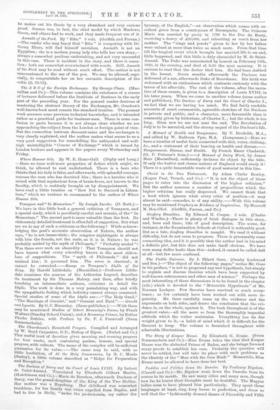The Duchess of Berry and the Court of Louis XVIII.
By Imbert de Saint-Amand. Translated by Elizabeth Gilbert Martin. (Hutchinson and Co.)—Marie de Bourbon, afterwards Duchess of Berry, was the grand-daughter of the King of the Two Sicilies. Her mother was a Hapsburg. Her childhood was somewhat troubloue, for her family was twice expelled from Naples, and had to live in Sicily, "under the protectorate, say rather the tyranny, of the English,"—an observation which comes with ex- cellent grace from a countryman of Buonaparte. The Princess Marie was married by proxy in 1798 to the Duo de Berry, receiving a dowry of £20,000, and inheriting as much from her mother. The "rings and jewels" given to her by her father were valued at more than twice as much more. From that time till the tragical event which brought her married life to an end, little happened, and this little is duly chronicled by M. de Saint- A mend. The Duke was assassinated by Louvel on February 13th, 1820, in the evening, and died at 6.30 the next morning. It is curious to read that the doctor bled him. He had been stabbed in the breast. Seven months afterwards the Duchess was delivered of a son, afterwards Duke of Bourdeaux. His birth was welcomed with an enthusiasm which contrasts curiously with the terror of his after-life. The rest of the volume, after the narra- tive of these events, is given to a description of Louis XVIII. in his later years. When we come to another volume (same author and publisher), The Duchess of Berry and the Court of Charles X., we feel that we are having too much. We find fairly readable accounts of court ceremonials, agreeable sketches of the Duchess in private and public, and a character, more favourable than is commonly given by historians, of Charles X. ; but the whole is too long. Even now we are not near the end. The Revolution of July is to be narrated, and the stormy sequel of the Duchess's life.


















































 Previous page
Previous page